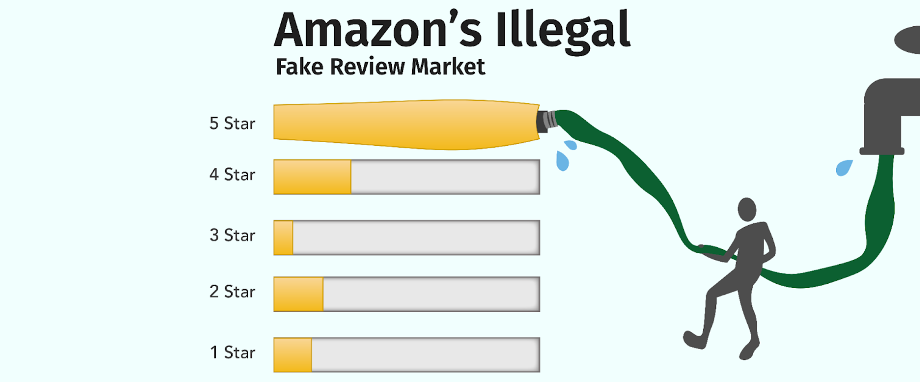Author: Suraj Sunkara
The BRB Bottomline
Good ratings are incredibly important when a consumer is considering to purchase a product. Because of this, many companies try to artificially inflate their ratings. Keep reading to learn about the various methods they employ to do so and some tips to spot these fraudulent/boosted products.
Ratings and reviews are the two key elements most consumers look at when deciding to purchase a product on Amazon. A 5-star review with mostly positive reviews likely means that the listing is a good deal. On the other hand, a product buried under 1 star reviews and negative comments is likely either fake or low quality.
The importance of ratings and reviews in customer decision making is very pronounced. A study by Pattern Insights demonstrates that increasing a product’s Amazon star rating from 3 to 5 can increase the product’s conversion rate by 12%. As with many things, however, there are people out there trying to game this system. Certain sellers will even go to the lengths of bribing people to leave good ratings and reviews. In exchange for a 5 star rating and a fantastic review, these sellers will shell out free products or even money.
This raises a huge problem for us as consumers. While Amazon does actively search for and remove fake reviews, many still pass through undetected. Not being sure as to what reviews are legitimate makes it incredibly difficult for us to differentiate low quality products from what we really want. Throughout the rest of this article, we will explore the common methods companies use to boost their product ratings and a few tips to avoid being tricked into buying second-rate goods.
How Companies Boost Product Ratings
While a company could realistically forge positive reviews and give good ratings to themself, getting caught would lead to some huge repercussions. Amazon mentions in their policies that they will terminate or suspend the Amazon privileges of any seller caught to be manipulating their reviews. Instead, sellers will resort to third-party companies that offer fake reviews in exchange for payment. These companies use an army of reviewers to leave hundreds to thousands of positive reviews on the product’s page. An investigation by Which? even found companies that promised an Amazon’s choice badge in less than two weeks. Many consumers (myself included) see the Amazon’s choice badge as a symbol for a high quality product. Unfortunately, as can be seen here, this is always not the case.
Another popular method companies will utilize to increase their ratings and generate positive reviews is review incentivization. Sellers will approach customers directly or use facebook groups and offer discounted or even free products in exchange for 5-star reviews. While this might be expensive for companies, it can be incredibly difficult to detect.
Tips to Avoid the Trap
As fake review companies grow more and more advanced, fake reviews are becoming increasingly more difficult to detect. Some companies even require their reviewer armies to leave reviews longer than two sentences along with photos. To avoid getting duped, many people suggest investigating reviewers behind overly positive comments to see whether they have a history of only leaving positive reviews. As college students, we don’t have the time or energy to do that. Instead, check out plugins like Fakespot that use real-time review analysis to tell you if a product is worth purchasing.
If you are skeptical about plugins (which is understandable), you can also sort reviews from lowest to highest. You can check whether an individual’s complaints about the product are relevant and determine if you want to buy the product from there. Similarly, you can also search for the product’s 3-star reviews and see why the customer gave it one. 3-star reviews tend to be the least biased and usually mention the pros and cons of a product.
Take-Home Points
Until Amazon comes up with some method to automatically remove all fake reviews, we can’t do much as customers besides try our best to not be fooled by fake reviews. Using plugins or filtering for lower star reviews are two ways to help you mitigate the chance of buying a low quality product. Finally, as a general rule of thumb, if you see a price too good to be true with a rating that’s too good to be true (and from an unknown seller), be wary.

